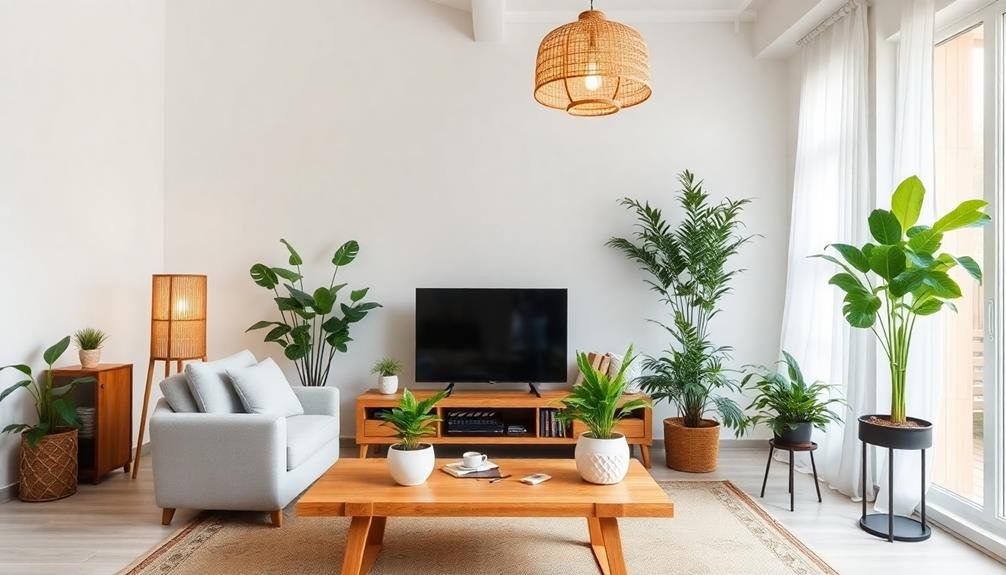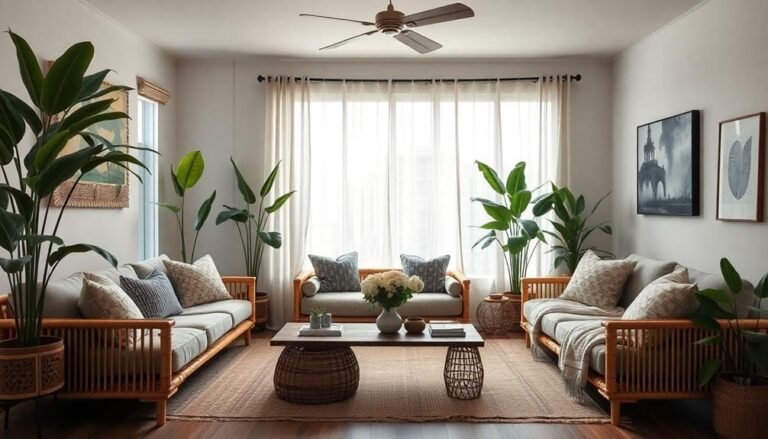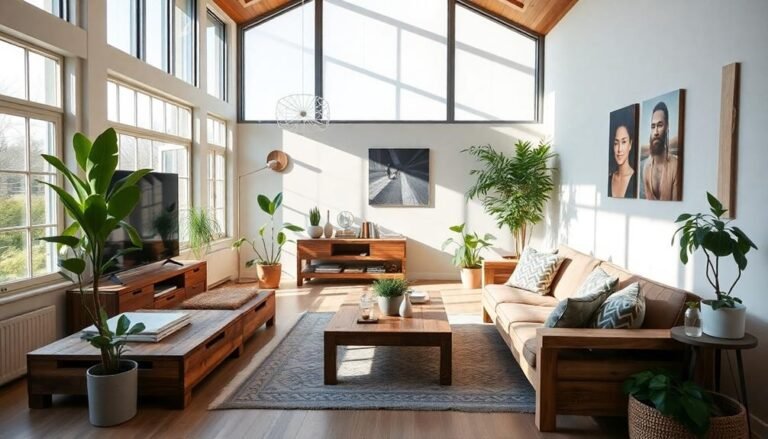To add sustainable lighting solutions to your home decor, start by evaluating your current lighting and identifying areas for improvement. Consider switching to energy-efficient LED bulbs, which consume less energy and last considerably longer than traditional options. Explore solar-powered lights for outdoor spaces, and integrate natural light by using mirrors and light colors in your decor. You can also repurpose recycled materials for unique fixtures, or opt for smart lighting solutions that allow you to control energy use. Vintage and upcycled fixtures not only reduce waste but also enhance your home's character. Discover even more creative ideas to elevate your decor.
Assess Your Current Lighting

To create a sustainable lighting setup, you first need to evaluate your current lighting. Take a walk through your home, and review each room's natural and artificial light sources. Ask yourself questions like: Are there areas that feel too dim, or others that seem overly bright? Identifying these inconsistencies will help you understand where changes are necessary. Consider exploring sustainable lighting options to enhance your space while being environmentally conscious.
Next, consider the purpose of each light fixture. Is a particular light being used frequently, or is it more decorative? Understanding how you use your lighting can help you prioritize which areas require improvement or adjustment.
Don't forget to check the types of bulbs you're currently using. Even if you're not switching to energy-efficient options just yet, knowing what you have can prepare you for future upgrades.
Lastly, think about your lifestyle. Do you often host gatherings, or do you prefer a cozy, quiet ambiance? Your lighting should reflect your daily activities and moods, enhancing your home's atmosphere while promoting sustainability. By thoughtfully evaluating your current lighting, you set the foundation for a more energy-efficient and harmonious living space.
Choose Energy-Efficient Bulbs

After evaluating your current lighting, it's time to focus on the types of bulbs you're using. Switching to energy-efficient bulbs can greatly reduce your energy consumption and lower your electricity bills. Compact fluorescent lamps (CFLs) and light-emitting diodes (LEDs) are two popular options that outshine traditional incandescent bulbs in both efficiency and lifespan.
For instance, an LED bulb uses about 75% less energy than an incandescent bulb, which means you can enjoy bright lighting without the hefty energy cost. Additionally, these bulbs often last up to 25,000 hours, making them a smart investment for your home.
When selecting bulbs, consider the brightness and color temperature that will best suit your space. LEDs come in various styles, from warm to cool light, allowing you to create the perfect ambiance for each room. Plus, many energy-efficient bulbs are now designed to fit standard fixtures, ensuring you won't need to change your existing light fixtures to accommodate them.
Explore Solar-Powered Options

One of the most innovative ways to enhance your home's lighting while reducing your carbon footprint is by exploring solar-powered options. Solar lights harness the sun's energy, making them an eco-friendly alternative to traditional lighting. You can install solar garden lights along pathways or in flower beds to create a warm, inviting atmosphere. These lights charge during the day and automatically turn on at dusk, offering both convenience and charm.
Additionally, consider solar-powered outdoor sconces or string lights for patios or decks. Not only do they add aesthetic appeal, but they also eliminate the need for wiring and reduce electricity costs. Many solar lighting options come with built-in sensors, ensuring they only operate when needed, further conserving energy.
If you're looking to brighten your indoor spaces, solar tubes can channel natural light into your home. They're a fantastic way to illuminate rooms without relying solely on electric lights. By making the switch to solar-powered lighting, you're investing in sustainable solutions that benefit the environment and your wallet. So, take the plunge and embrace solar-powered options; your home will shine brighter, and you'll feel good about your contribution to a greener planet.
Incorporate Recycled Materials

Incorporating recycled materials into your home lighting design can greatly enhance both sustainability and style. You can create unique lighting fixtures that not only brighten your space but also tell a story. By using items that would otherwise end up in a landfill, you're making a positive impact while adding character to your decor. This approach not only contributes to a more eco-friendly environment but also allows for a wide range of creative expressions found in recycled home decor ideas.
Consider these options to get started:
- Glass jars or bottles: Transform them into pendant lights or lanterns for a charming, rustic look.
- Wood scraps: Use reclaimed wood to construct lamp bases or light shades, giving your home a warm, natural feel.
- Metal components: Old metal pipes or cans can be creatively repurposed into modern industrial-style fixtures.
- Recycled paper: Craft custom lampshades from old magazines or newspapers, adding a touch of creativity and color to your lighting.
Opt for Smart Lighting Solutions

Smart lighting solutions can revolutionize your home's energy efficiency and ambiance. By using smart bulbs and fixtures, you can easily control the brightness and color of your lights, adjusting them based on your mood or activity. Imagine being able to dim the lights for movie night or brighten them for focused homework sessions, all with a simple voice command or tap on your smartphone.
These advanced lighting systems often come with energy-saving features, like timers and motion sensors, which help reduce electricity consumption. For instance, you can set your lights to turn off automatically when you leave a room, preventing unnecessary energy waste. Additionally, many smart bulbs connect to home automation systems, allowing you to create schedules or integrate them with other eco-friendly devices, like smart thermostats.
Moreover, some smart lighting options even offer customization, enabling you to choose from millions of colors and shades. This flexibility not only enhances your home's aesthetics but also contributes to a sustainable lifestyle by minimizing energy use. By opting for smart lighting solutions, you're not just improving your home decor; you're making a conscious choice that benefits the environment and your wallet.
Utilize Natural Light

Harnessing the power of natural light can transform your living space while markedly reducing energy consumption. By maximizing sunlight, you not only create a brighter atmosphere but also lower your reliance on artificial lighting. Here are some effective ways to utilize natural light in your home:
- Choose Light Colors: Use light-colored paint and decor, as they reflect sunlight and make rooms feel more spacious and airy.
- Position Mirrors Strategically: Place mirrors across from windows to bounce light around the room, enhancing brightness and warmth.
- Open Up Window Treatments: Opt for sheer curtains or blinds that allow sunlight to filter in while still providing some privacy.
- Create Open Spaces: Rearranging furniture to keep pathways clear of light can help sunlight reach every corner of your room.
Consider Vintage and Upcycled Fixtures

Vintage and upcycled fixtures add character and a unique charm to your home decor while promoting sustainability. By choosing these distinctive pieces, you not only embrace history but also contribute to reducing waste in our environment. For instance, you could find an old chandelier at a flea market that, with a little cleaning and perhaps new bulbs, becomes a stunning focal point in your dining room. You might also consider incorporating stylish industrial floor lamps, which can enhance the aesthetic while providing excellent lighting options for your space stylish industrial floor lamps.
When considering vintage fixtures, think about the style that resonates with you. Whether it's mid-century modern or rustic farmhouse, there's a wealth of options available that can blend seamlessly into your existing decor. Upcycling is another fantastic route; you might transform an old lamp base by applying a fresh coat of paint or swapping out the shade for something more contemporary.
Incorporating these fixtures not only showcases your personal taste but also tells a story, sparking conversations with guests. Additionally, you'll save money compared to buying new items, all while supporting sustainable practices. So, next time you're on the hunt for lighting, don't overlook the charm and eco-friendliness of vintage and upcycled options. They're not just stylish; they're also a step toward a more sustainable home.
Frequently Asked Questions
What Are the Benefits of Using LED Bulbs Over Traditional Bulbs?
Using LED bulbs over traditional incandescent ones offers numerous benefits. You'll notice that LEDs consume up to 80% less energy, which helps lower your electricity bills. They also last considerably longer—up to 25,000 hours—reducing the frequency of replacements. Additionally, LEDs emit less heat, making them safer and more efficient. By switching to LEDs, you not only save money but also contribute to a more sustainable environment, which is essential for future generations.
How Can I Calculate the Energy Savings From Sustainable Lighting?
To calculate energy savings from sustainable lighting, start by comparing wattage. For instance, if you switch from a 60-watt incandescent bulb to a 10-watt LED, you're saving 50 watts per bulb. Multiply this by the number of hours you use the bulb daily, then by the number of days it's used in a year. Finally, multiply by your local energy rate to find annual savings. This simple math can reveal significant benefits!
Are There Specific Brands Known for Sustainable Lighting Products?
When it comes to sustainable lighting, you'll find several standout brands that prioritize eco-friendliness. Philips Hue offers smart LED options that save energy and enhance ambiance. Similarly, GE's Reveal LED bulbs improve light quality while being energy-efficient. If you're looking for stylish designs, check out brands like West Elm or CB2, which feature eco-conscious lighting solutions. By choosing these brands, you not only illuminate your space but also contribute to a greener future.
How Often Should I Replace My Sustainable Light Fixtures?
You should replace your sustainable light fixtures every 5 to 10 years, depending on their type and usage. For example, LED lights often last longer than traditional bulbs, reducing the frequency of replacements. However, you'll want to inspect them regularly for signs of wear or decreased brightness. Staying proactive can guarantee you maintain efficiency and save on energy costs, while also keeping your home well-lit and aesthetically pleasing.
Can Sustainable Lighting Improve My Home's Resale Value?
Yes, sustainable lighting can improve your home's resale value. Buyers increasingly seek energy-efficient features, and eco-friendly lighting options can make your property more attractive. For instance, LED fixtures not only lower energy bills but also enhance the overall aesthetic appeal of your space. By investing in sustainable lighting, you're not just saving money; you're also appealing to environmentally conscious buyers, which can lead to a quicker sale and potentially higher offers.




